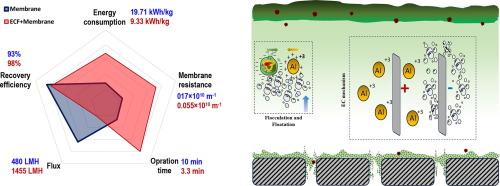Amalgamation of electrocoagulation-flotation and membrane technology: Rapid and efficient microalgal biomass recovery and fouling mitigation
IF 13.3
1区 工程技术
Q1 ENGINEERING, CHEMICAL
引用次数: 0
Abstract
This study presents an innovative microalgae recovery and fouling mitigation technology that combines electrocoagulation-flotation (ECF) and membrane processes to achieve a rapid and efficient microalgae recovery while mitigating fouling. Under the same conditions, applying 1.5 A current significantly improved the average water flux (from 480 to 1455 LMH) and membrane rejection rate (from 93 % to 98 %) compared to the membrane filtration process without ECF. The total fouling resistances also decreased by approximately 67 % (from 0.17 × 1010 to 0.055 × 1010 m−1). The molecular dynamic simulation, along with chemical and imaging analyses, revealed that the Al3+ ions (37 mg/L) released from the aluminum anode, combined with the bubbles generated from the cathode, effectively coagulated and floated the microalgal biomass on the suspension surface. This process significantly reduced cake formation on the membrane. Furthermore, the fouling model simulations indicated that ECF could change the fouling mechanism, shifting from cake filtration to an intermediate standard model. The findings suggested that integrating ECF with membrane filtration could reduce the operational time from 10 to 3.3 min, which resulted in a significant reduction in energy consumption from 19.71 to 9.14 kWh/kg biomass (approximately to half). This study offers a promising approach for rapid and efficient microalgae harvesting through the membrane filtration process.

求助全文
约1分钟内获得全文
求助全文
来源期刊

Chemical Engineering Journal
工程技术-工程:化工
CiteScore
21.70
自引率
9.30%
发文量
6781
审稿时长
2.4 months
期刊介绍:
The Chemical Engineering Journal is an international research journal that invites contributions of original and novel fundamental research. It aims to provide an international platform for presenting original fundamental research, interpretative reviews, and discussions on new developments in chemical engineering. The journal welcomes papers that describe novel theory and its practical application, as well as those that demonstrate the transfer of techniques from other disciplines. It also welcomes reports on carefully conducted experimental work that is soundly interpreted. The main focus of the journal is on original and rigorous research results that have broad significance. The Catalysis section within the Chemical Engineering Journal focuses specifically on Experimental and Theoretical studies in the fields of heterogeneous catalysis, molecular catalysis, and biocatalysis. These studies have industrial impact on various sectors such as chemicals, energy, materials, foods, healthcare, and environmental protection.
 求助内容:
求助内容: 应助结果提醒方式:
应助结果提醒方式:


